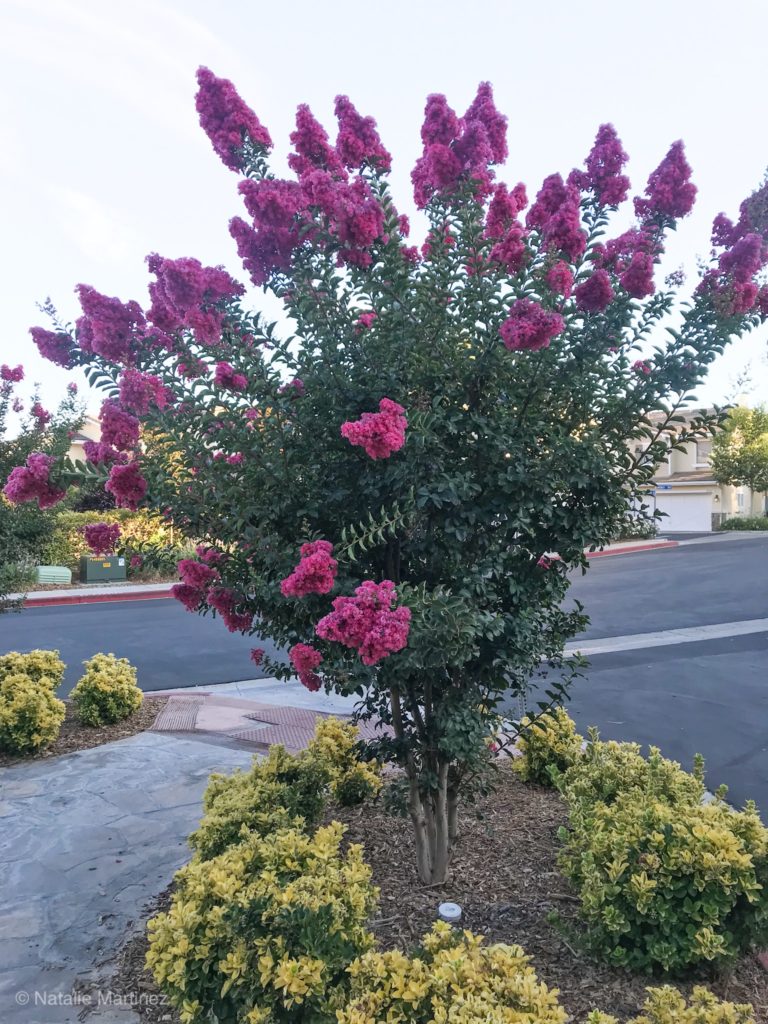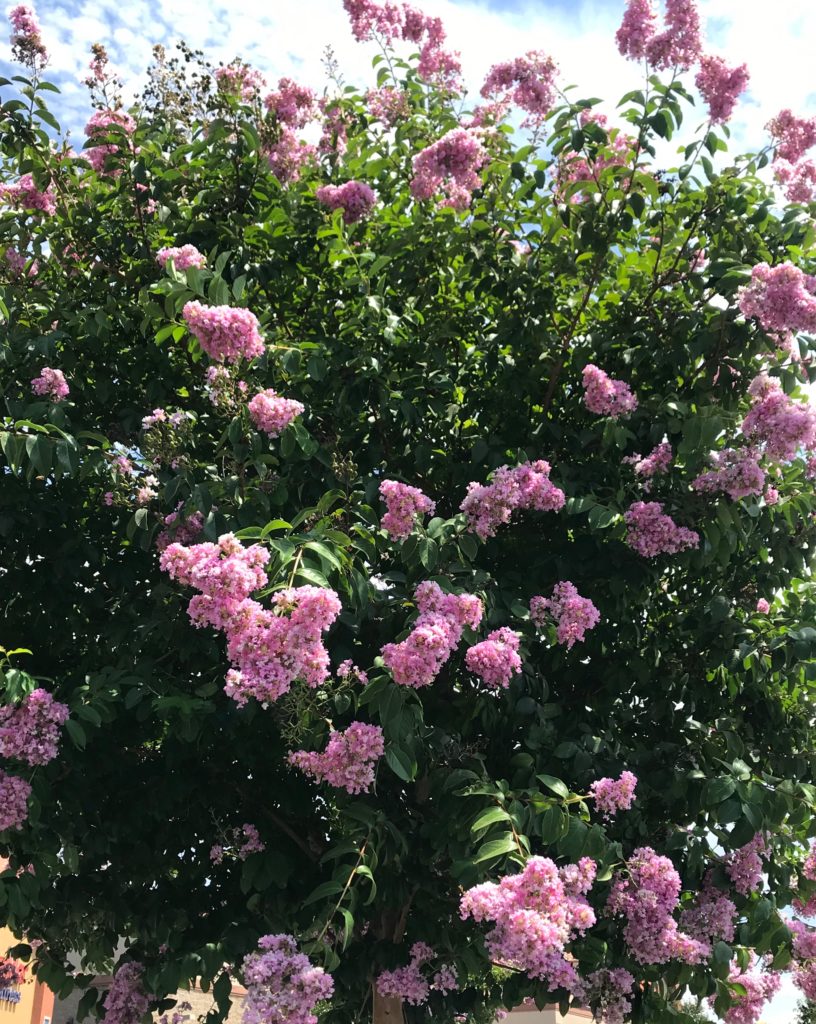How to Grow Crepe Myrtle Trees
Crepe Myrtles are beautiful and hardy flowering trees that can be grown almost anywhere in the United States.
They’re especially popular in the South, where you’ll see them in front yards, parks, and along sidewalks because they do so well in the summer heat.
I’m frankly obsessed with crepe myrtles and I always stop to photograph them whenever I see one!
Many people are enamored with lilacs and lilac bushes, and I think Crepe Myrtles are an excellent alternative to lilacs.
They’re just as beautiful but they’re long-blooming, unlike lilac shrubs, which only bloom for two weeks in the Spring.
Crepe Myrtles begin to bloom during late spring in warm zones and will continue to bloom throughout the summer and into the fall.
If you long to grow trees that produce generous clusters of flowers but can also withstand hot summer days and humidity, then Crepe Myrtle trees are a perfect choice.
Tree varieties can grow 15 to 20 feet tall, whereas dwarf varieties can grow 12 to 24 inches tall.
Dwarf varieties take the shape of a shrub and make excellent garden fillers in borders or garden beds behind smaller plants.
You can find varieties that produce flowers in shades of white, lilac (my favorite), or bright pink flowers.
The tree trunks are beautiful, too. They’re thin and the bark is birch-like.
I personally love Crepe Myrtle trees because they grow so well in my zone (Zone 9b, Southern California).
We experience triple-digit summers and warm winters here with very little rainfall, and yet these beautiful trees STILL produce such vibrant blooms for months on end.
It’s almost unbelievable how resilient they are.
If you’re interested in growing one or two of these beautiful trees in your yard, these tips will come in handy.
How to Plant Crepe Myrtle Trees
Crepe Myrtles can be planted in early Spring or Fall, as long as its before the first frost.
However, if you purchase a pot that’s already blooming, you can plant it in late Spring or Summer.
When you bring it home from the garden center, give the pot a good watering. You want the root ball to be moist when you plant it.
Make sure you plant in a spot that gets at least 6 hours of direct sunlight each day – this is a sun-loving plant.
The spot should also be slightly elevated so that the soil drains well and doesn’t collect.
You don’t want any water puddles around this tree or shrub!
Also, well-drained soil with a pH level is 5.0 to 6.5 is ideal. If you don’t know your soil’s pH, you can test it yourself with a pH meter from your local garden center or hardware store.
Once you choose your planting spot, dig a hole that is the same depth as the pot and twice the diameter so that the root system has room to spread.
Gently remove the tree from its pot so that the roots stay intact, and place it into the hole.
Remember this important tip: Do not plant this tree too deeply into the ground.
In fact, you want the root ball to be just slightly under the topsoil, even if it’s still visible after planting.
After planting, water the area generously to help the roots establish. You can help lock in moisture and keep the soil cool by placing mulch around the base of the stem.
How to Water Crepe Myrtles
After the initial watering, you can water once a week or a few times a week during the summer.
As with most plants, regular watering during those first few weeks will help your Crepe Myrtle grow strong and healthy.
Fertilizer:
Fertilizing your tree can prove beneficial. Do not, however, over-fertilize. In early Spring, try working a high-nitrogen fertilizer into the soil.
Repeat again after two months for best results. Fertilizer will help your tree produce full, beautiful blooms.
Pruning Crepe Myrtles
Here’s the good news: if you plan to grow your Crepe Myrtle as a tree, then you don’t need to do too much pruning!
Many people actually prefer to skip the pruning altogether, preferring the tree’s natural shape. Pruning can, however, help the tree produce better blooms and keep it from getting too tall.
Deadheading is also beneficial. Once you see dead flower heads, take your pruning shears and deadhead them as you would any other flower.
Just cut below the dead flower cluster to encourage a second bloom.
Here’s something I want to stress about crepe myrtle care: Do not lop off the branches down to the trunk after bloom- this will kill your crepe myrtle’s chances of producing strong, thick branches that can hold up flowers.
All you’ll be left with is an ugly tree that has no winter interest and won’t be able to grow generous clusters of blooms come summer and fall.
To prune properly, prune in late winter. Pruning before Winter can make your tree susceptible to winter freeze, which will ruin its chances of flowering.
Crepe Myrtles bloom on new wood, so pruning in Winter won’t affect blooming.
Here’s what you should prune:
- Any small shoots aka suckers that come from the base of the plant
- Any branches that are rubbing against each other and corssing, especially in the middle of the tree, because this decreases air circulation.
- Any dead branches
- Up to 2 feet off the tallest branches, to keep the tree from getting too tall for your liking
Pruning tip: Aim to only cut back stems that connect to a larger stem. You don’t want any stubs after pruning.
I hope this post helps you grow a beautiful crepe myrtle tree in your yard!
I think you’ll love its low-maintenance nature and resiliency. You soon find that crepe myrtles have something to offer year-round!


Will grape myrtles grow in Zone 5 (NY state?
Hi Jeanine,
To grow this tree in New York, look for hardy crape myrtle hybrids, which were developed to withstand colder winters. Make sure to plant your tree now (Summer) while the soil is warm so that the roots have time to establish before Fall. Also, make sure to plant it in a full-sun spot.
Good luck!